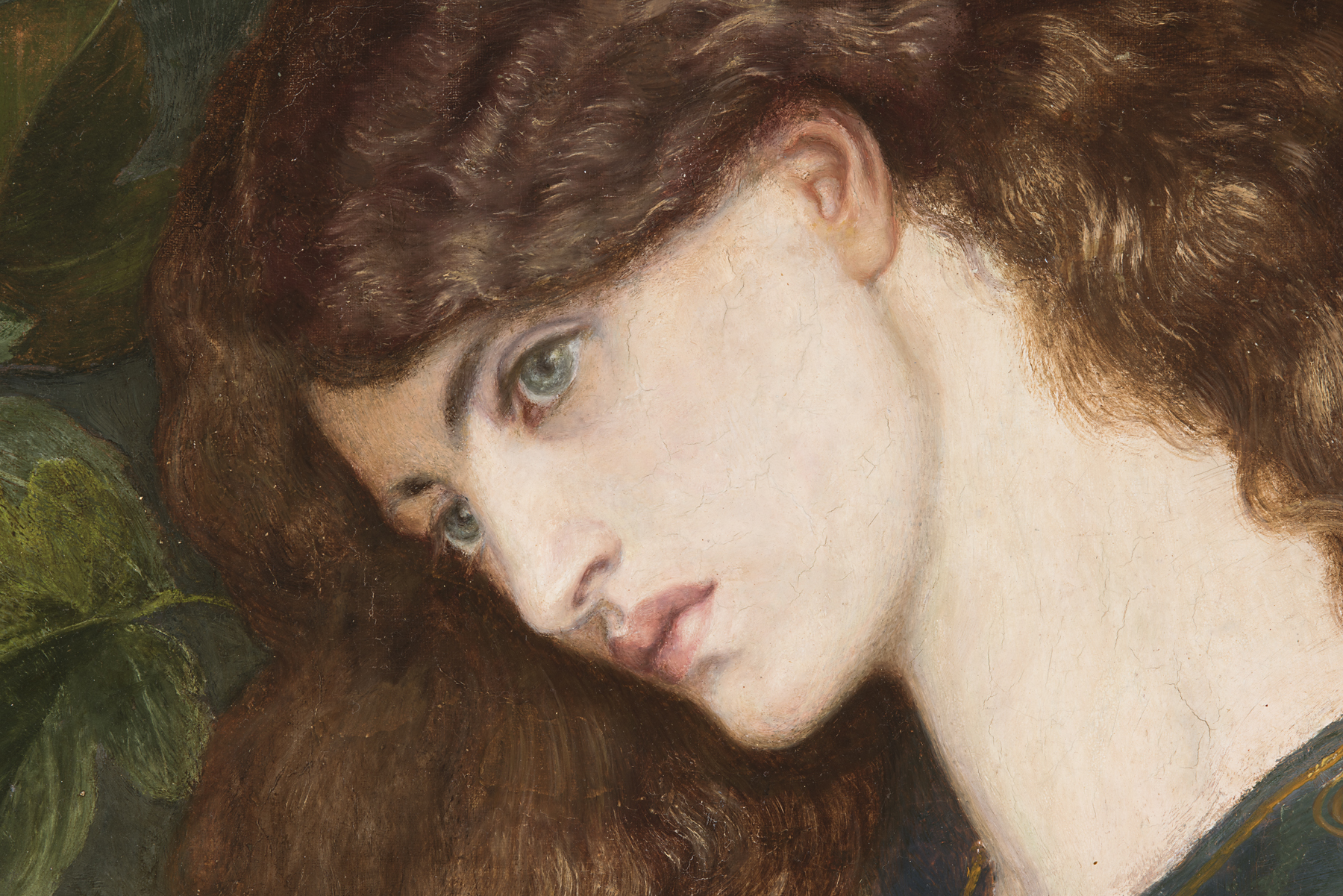La Pia de' Tolomei, Dante Gabriel Rossetti
Artwork Overview

Canvas/Support (Height x Width x Depth): 104.8 x 120.6 cm
Canvas/Support (Height x Width x Depth): 41 1/4 x 47 1/2 in
Frame Dimensions (Height x Width x Depth): 57 x 62 1/2 x 3 1/2 in
If you wish to reproduce this image, please submit an image request
Images
Label texts
La Pia is the last major painting completed by Rossetti. It portrays a character from the epic 14th-century poem, The Divine Comedy, Purgatory by the Italian poet Dante Alighieri (circa 1265–1321). According to the poem, a woman named La Pia married an Italian magistrate who kept her in a castle in the malaria-infested swamps of Maremma where she died under mysterious circumstances. In this painting, Rossetti captures the lonely and contemplative young woman toying with her wedding ring. In the foreground, the sundial suggests the passage of time, while old love letters from her husband underscore La Pia’s marital ties.
Rossetti’s model for this painting and many others was Jane Burden Morris (1839–1914), who was married to Rossetti’s fellow artist and good friend, William Morris. Rossetti had a passionate affair with Jane and hoped in vain that she would leave her husband. Thus, the subject of a wife imprisoned by her husband carried great personal meaning for Rossetti.
The epic, 14th-century poem The Divine Comedy includes the tragic story of La Pia de' Tolomei. Held captive in a castle in Italy by her jealous and powerful husband, La Pia’s tale of love, resilience, and eventual demise is conveyed through symbolic imagery. Black ravens, a sundial, discarded love letters, a prayer book and beads, and clinging ivy contribute to an image of a pious and faithful wife who put her trust in the wrong person.
The epic, 14th-century poem The Divine Comedy includes the tragic story of La Pia de' Tolomei. Held captive in a castle in Italy by her jealous and powerful husband, La Pia’s tale of love, resilience, and eventual demise is conveyed through symbolic imagery. Black ravens, a sundial, discarded love letters, a prayer book and beads, and clinging ivy contribute to an image of a pious and faithful wife who put her trust in the wrong person.
La Pia de' Tolomei is the last major painting completed by Dante Gabriel Rossetti. It depicts La Pia, a character from The Divine Comedy by Italian poet Dante Alighieri (circa 1265–1321). La Pia married an Italian magistrate who kept her in a castle in the swamps of Maremma where she died under mysterious circumstances. Rossetti captures the lonely and contemplative young woman toying with her wedding ring. A sundial in the foreground suggests the passage of time, while old love letters from her husband underscore La Pia’s marital ties.
La Pia de' Tolomei is the last major painting completed by Dante Gabriel Rossetti. It depicts La Pia, a character from The Divine Comedy by Italian poet Dante Alighieri (circa 1265–1321). La Pia married an Italian magistrate who kept her in a castle in the swamps of Maremma where she died under mysterious circumstances. Rossetti captures the lonely and contemplative young woman toying with her wedding ring. A sundial in the foreground suggests the passage of time, while old love letters from her husband underscore La Pia’s marital ties.
The next section of the Museum holds two related exhibitions, Forms of Thought and This Land. Within Forms of Thought, we invite you to think about the ways in which artists make intangible ideas visible.
On the frame of this painting, Rossetti has carefully copied lines from the epic poem The Divine Comedy, by the 14th-century Italian poet Dante Alighieri. According to local myth, a woman named La Pia married an Italian magistrate who kept her in a castle in the malaria-infested swamps of Maremma, Italy, where she died under mysterious circumstances. Tap the Web icon to watch part of an opera depicting this story. Rossetti had an affair with the model for this painting, Jane Morris, and hoped in vain that she would leave her husband for him. Tap the Web icon to see more of Rossetti’s paintings of Jane Morris. Thus, the subject of a wife imprisoned by her husband carried great personal meaning for Rossetti.
How does this myth translate into the visual medium of the painting? What does the painting tell us about this woman and her story?
The next section of the Museum holds two related exhibitions, Forms of Thought and This Land. Within Forms of Thought, we invite you to think about the ways in which artists make intangible ideas visible.
On the frame of this painting, Rossetti has carefully copied lines from the epic poem The Divine Comedy, by the 14th-century Italian poet Dante Alighieri. According to local myth, a woman named La Pia married an Italian magistrate who kept her in a castle in the malaria-infested swamps of Maremma, Italy, where she died under mysterious circumstances. Rossetti had an affair with the model for this painting, Jane Morris, and hoped in vain that she would leave her husband for him. Thus, the subject of a wife imprisoned by her husband carried great personal meaning for Rossetti.
How does this myth translate into the visual medium of the painting? What does the painting tell us about this woman and her story?
Click on the audio tab above to listen to a student's interpretation of this object.
La Pia is the last major painting completed by Rossetti. It portrays a character from the epic 14th-century poem, The Divine Comedy, Purgatory by the Italian poet Dante Alighieri (circa 1265–1321). According to the poem, a woman named La Pia married an Italian magistrate who kept her in a castle in the malaria-infested swamps of Maremma, where she died under mysterious circumstances. In this painting, Rossetti captures the lonely and contemplative young woman toying with her wedding ring. In the foreground, the sundial suggests the passage of time, while old love letters from her husband underscore La Pia’s marital ties.
Rossetti’s model for this and many other paintings was Jane Burden Morris (1839–1914), who was married to Rossetti’s fellow artist and good friend, William Morris. Rossetti had a passionate affair with Jane, and had hoped in vain that she would leave her husband for him. Thus, the subject of a wife imprisoned by her husband carried great personal meaning for Rossetti.
La Pia is the last major painting completed by Rossetti. It portrays a character from the epic 14th-century poem, The Divine Comedy, Purgatory by the Italian poet Dante Alighieri (circa 1265–1321). According to the poem, a woman named La Pia married an Italian magistrate who kept her in a castle in the malaria-infested swamps of Maremma, where she died under mysterious circumstances. In this painting, Rossetti captures the lonely and contemplative young woman toying with her wedding ring. In the foreground, the sundial suggests the passage of time, while old love letters from her husband underscore La Pia’s marital ties.
Rossetti’s model for this and many other paintings was Jane Burden Morris (1839–1914), who was married to Rossetti’s fellow artist and good friend, William Morris. Rossetti had a passionate affair with Jane, and had hoped in vain that she would leave her husband for him. Thus, the subject of a wife imprisoned by her husband carried great personal meaning for Rossetti.
La Pia is the last major painting completed by Rossetti. It portrays a character from the epic 14th-century poem, The Divine Comedy, Purgatory by the Italian poet Dante Alighieri (circa 1265–1321). According to the poem, a woman named La Pia married an Italian magistrate who kept her in a castle in the malaria-infested swamps of Maremma where she died under mysterious circumstances. In this painting, Rossetti captures the lonely and contemplative young woman toying with her wedding ring. In the foreground, the sundial suggests the passage of time, while old love letters from her husband underscore La Pia’s marital ties.
Rossetti’s model for this painting and many others was Jane Burden Morris (1839–1914), who was married to Rossetti’s fellow artist and good friend, William Morris. Rossetti had a passionate affair with Jane and hoped in vain that she would leave her husband. Thus, the subject of a wife imprisoned by her husband carried great personal meaning for Rossetti.
La Pia is the last major painting completed by Rossetti. It portrays a character from the epic 14th-century poem, The Divine Comedy, Purgatory by the Italian poet Dante Alighieri (circa 1265-1321). According to the poem, a woman named La Pia married an Italian magistrate who kept her in a castle in the malaria-infested swamps of Maremma where she died under mysterious circumstances. In this painting, Rossetti captures the lonely and contemplative young woman toying with her wedding ring. In the foreground, the sundial suggests the passage of time, while old love letters from her husband underscore La Pia’s marital ties.
Rossetti’s model for painting and many others was Jane Burden Morris (1839-1914), who was married to Rossetti’s fellow artist and good friend, William Morris. Rossetti had a passionate affair with Jane and hoped in vain that she would leave her husband. The subject of a wife imprisoned by her husband carried great personal meaning for Rossetti.
La Pia is the last major painting completed by Rossetti. It portrays a character from the epic 14th-century poem, The Divine Comedy, Purgatory by the Italian poet Dante Alighieri (circa 1265-1321). According to the poem, a woman named La Pia married an Italian magistrate who kept her in a castle in the malaria-infested swamps of Maremma where she died under mysterious circumstances. In this painting, Rossetti captures the lonely and contemplative young woman toying with her wedding ring. In the foreground, the sundial suggests the passage of time, while old love letters from her husband underscore La Pia’s marital ties.
Rossetti’s model for painting and many others was Jane Burden Morris (1839-1914), who was married to Rossetti’s fellow artist and good friend, William Morris. Rossetti had a passionate affair with Jane and hoped in vain that she would leave her husband. The subject of a wife imprisoned by her husband carried great personal meaning for Rossetti.
Exhibition Label:
"Forms of Thought," Mar-2014, Kris Ercums
La Pia is the last major painting completed by Rossetti. It portrays a character from the epic 14th-century poem, The Divine Comedy, Purgatory by the Italian poet Dante Alighieri (circa 1265-1321). According to the poem, a woman named La Pia married an Italian magistrate who kept her in a castle in the malaria-infested swamps of Maremma where she died under mysterious circumstances. In this painting, Rossetti captures the lonely and contemplative young woman toying with her wedding ring. In the foreground, the sundial suggests the passage of time, while old love letters from her husband underscore La Pia’s marital ties.
Rossetti’s model for painting and many others was Jane Burden Morris (1839-1914), who was married to Rossetti’s fellow artist and good friend, William Morris. Rossetti had a passionate affair with Jane and hoped in vain that she would leave her husband. The subject of a wife imprisoned by her husband carried great personal meaning for Rossetti.
Archive Label 2001:
La Pia, the last major canvas completed by Rossetti, depicts one of the characters of the thirteenth to fourteenth century Italian poet Dante Alighieri from his epic poem The Divine Comedy, Purgatory. The relevant part of this poem is inscribed on this, the original frame, designed by Rossetti himself.
La Pia, of the Sienese family Tolommei, married a magistrate from Maremma. He kept her, supposedly out of jealousy, in a castle on the malaria-infested swamps of Maremma. She died there under mysterious circumstances. She is seen here fingering her wedding ring in sadness and regret. The old letters from her husband and the sundial in the fore-ground, a symbol of change, explicate the narrative, the rosary and devotional book refer to her name, which means "the pious one."
The model for this and many other Rossetti paintings was Jane Burden Morris. Rossetti favored this type of model with her thick, dark hair, brooding eyes, heavy neck and plump, curling mouth. The heavy-hearted theme of La Pia was especially poignant for Rossetti, who was in love with Jane Morris even though she was married to a fellow artist and good friend, William Morris.
Archive Label:
La Pia, the last major canvas completed by Rossetti, depicts one of the characters from the epic fourteenth-century poem, The Divine Comedy, Purgatory, by the Italian poet Dante Alighieri. Passages from this poem that relate directly to the painting are inscribed on the frame, which Rossetti designed himself.
La Pia married an Italian magistrate who kept her, supposedly out of jealousy, in a castle in the malaria-infeseed swamps of Maremma. She died there under mysterious circumstances. Rossetti shows a lonely and contemplatve La Pia toying with her wedding rings. In the foreground, the sundial suggests the passage of time, while old love letters from her husband underscore La Pia's marital ties. The rosary and devotional book refer to her name, which means "the pious one."
Rossetti's model for this and many other paintings was Jane Burden Morris, who was married to Rossetti's fellow artist and good friend, William Morris. Rossetti had a passionate affair with Jane, and hoped in vain that she would leave William for him. Therefore, La Pia's subject of a wife imprisioned by her husband carried much personal meaning for Rossetti.
Exhibitions
Celka Straughn, curator
Kristina Walker, curator
Angela Watts, curator
Celka Straughn, curator
Kristina Walker, curator
Angela Watts, curator







































